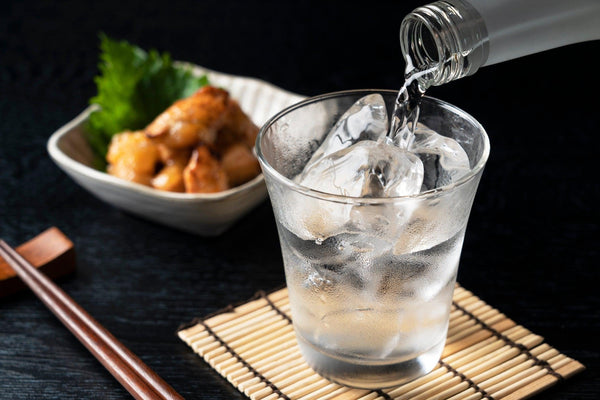
Jump to:
Nihonshu, which is always made from rice and is commonly known outside of Japan as “sake” (which is, in fact, the general word for alcohol in Japanese) is widely considered to be the national beverage of Japan.
However, you may be surprised to know that another Japanese alcoholic beverage, Shochu has a higher consumption in Japan than Nihonshu. In this article, we will look at what Shochu is, consider its history, look at how it is made and how it is drunk, as well as looking at some regional varieties. We will then go on to compare it to other types of Japanese alcohol, such as Nihonshu and Soju, and look at some possible benefits of drinking Shochu, before rounding up by considering different options for purchasing Shochu.
What Is Shochu?
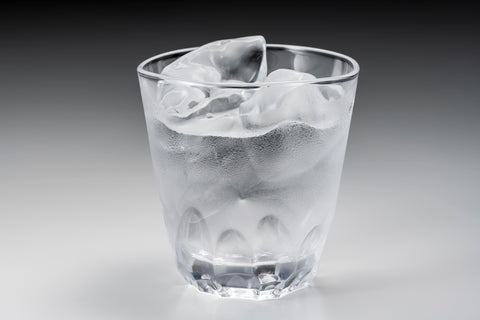
As noted previously, Nihonshu, without exception, is made with rice as its base ingredient. Shochu, however, is a lot more diverse, and, in addition to rice, it commonly uses ingredients such as satsumaimo (sweet potato), barley, buckwheat, shiso, and sugar cane. Possibly because of the similarity in having potatoes as one of its ingredients, Shochu has sometimes been dubbed Japanese vodka, but this is slightly misleading as whereas vodka has an alcohol percentage of 35-40%, Shochu is rarely this strong and is normally within the 25-30% range. It is commonly mixed with hot or cold water, which brings down the percentage even further.
History Of Shochu
So, what are the origins of Shochu and when did it first become popular in Japan?
Unlike Nihonshu, Shochu relies on a manufacturing process called distillation, which will be described in a little more detail later in this post. Distillation dates back as far as the Mesopotamian civilizations of 4 to 3 BC and was even the subject of a paper by the Greek philosopher Aristotle.
However, it was not until the Muromachi period (around the 15th century) that distillation was first used in Japan. Shochu soon followed, and the first record we have that details Shochu consumption is by the Portuguese merchant Jorge Alvarez, who wrote in a report to Francisco Xavier that "people were drinking oraka (shochu) made from rice," and this suggests that the production technique was introduced to Kyushu in south Japan around the 16th century.
The first types of Shochu were made from rice and grains, but in the early seventeenth century, sweet potato was introduced to the Ryukyu kingdom (modern-day Okinawa) by merchants from China. It was discovered that the Okinawan climate suited the cultivation of sweet potatoes, and due to the ease of growing them, they spread like wildfire and started to be used in Shochu making, particularly in the Kyushu area of southern Japan.
Now that we have considered how it all started, let's dive into how Shochu is made.
How Is Shochu Made?
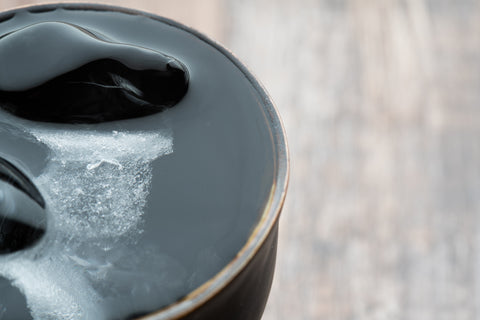
Like Nihonshu, Shochu is made by adding the base ingredient and water to a yeast mash. This is then combined with Koji and the mixture is then fermented for around ten days. So far, this closely resembles the process of making Nihonshu, but a key difference is that Shochu then goes through a further process of distillation.
Put simply, distillation is a process that involves the conversion of a liquid into a vapor, following which the vapor is then condensed back into liquid form. This process separates the alcohol from the fermented materials, with the distilled alcohol being known as the distillate.
Vodka goes through the distilling process multiple times, accounting for its high alcohol content. Shochu, however, is commonly distilled only once, as it is believed that this more reliably retains the original flavor of the base ingredients.
Ways Of Drinking Shochu
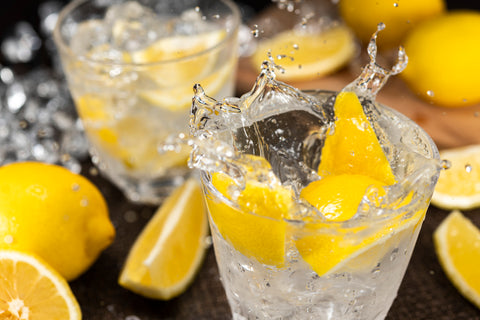
There are many ways of enjoying Shochu. Some Shochu purists may swear that the only true way to drink it is straight, but given its high alcohol content you need to be a fairly hard-core drinker to enjoy it this way, and it is often mixed with other things to reduce its strength.
In the case of Mizuwari, it is mixed with cold water and ice, and the alcohol percentage can be reduced to match the drinker’s preference by adjusting the amount of water. The same thing goes for Oyuwari, popularly enjoyed during the cold winter months, in which it is mixed with hot water (approximately 40-45℃). As with most hard liquor, Shochu is also commonly enjoyed just with ice, or “on the rocks”.
Another reason for the high consumption of Shochu is its popularity in the Chuhai form. This is a ready-made drink that combines Shochu and flavored carbonated water. Popular flavors of Chuhai include citrus fruits, such as lemon and lime, as well as peach, melon, and many other types of fruit. It can be found not only in bars and restaurants but also in canned form at your local supermarket or convenience store.
Regional Varieties Of Shochu
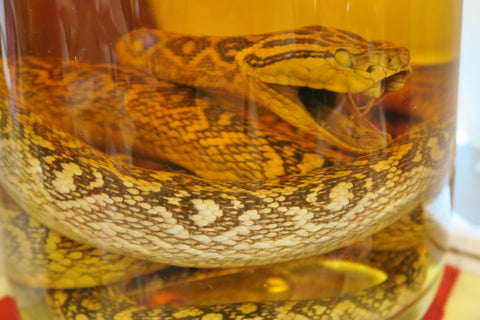
If you try Shochu and find that you like it, it may be interesting to try a number of regional varieties to see which one best suits your taste. The predominant Shochu-producing regions are the southern islands of Kyushu and Okinawa.
Iki Shochu is made from barley and hails from Iki island in Nagasaki. Kuma Shochu also comes from Kyushu, this time from Kumamoto prefecture, and is made of rice. Kagoshima prefecture’s contribution to Shochu can be found in Satsuma Shochu, which, as the name suggests, uses satsumaimo sweet potatoes as the base ingredient. Finally, Awamori, from Okinawa, is an extremely strong variety of Shochu made from rice and black Koji mold.
Comparison With Other Types Of Liquor
Now, let us consider how Shochu is similar to and differs from, other types of Japanese liquor.
Shochu Vs Nihonshu

As described before, Nihonshu is similar to Shochu in that it uses simple ingredients and is fermented using yeast and Koji, a type of mold. However, whereas Nihonshu is brewed, Shochu is distilled, and this gives it a higher ABV (alcohol by volume) than sake. Both pair well with food, but as Shochu uses a variety of base ingredients, you may need to tweak your choice of combinations through trial and error (or find a good matching guide) when trying to match Shochu with various types of cuisine.
Shochu Vs Soju
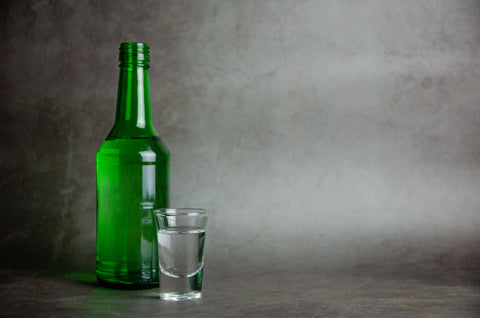
A less well-known beverage available in Japan is Soju. Like Shochu, it is distilled but has a huge range of ABV depending on the type (between 16% and 45%). Traditionally a Korean beverage, Soju is often sipped neat and is effective for cleansing the palate, particularly after enjoying oily foods or foods with bold flavors.
Is Shochu Healthy?
Whereas the normal caveats apply regarding the dangers of liver damage from over-indulgence in any form of alcohol, there is no doubt that Shochu is a healthier option than some other alcoholic beverages.
It uses only natural ingredients, is basically carb-free, extremely low in calories, and does not contain purines (a compound commonly found in beer that raises uric acid levels). It contains the enzyme urokinase, which is also available in red wine and is lauded as having the ability to prevent strokes and heart attacks.
There is also an argument that because it does not contain sugar or other impurities, and therefore does not raise your blood sugar, you are less likely to suffer from a hangover after a hard night’s drinking. This last point, in particular, is rather debatable, but it may be fun to find out!
Where To Buy Shochu
So hopefully the above has whetted your appetite, and you are interested in trying Shochu out for yourself. But where can you get Shochu? If you are in Japan, you will not need to look too far. You can find Shochu not only in bars and restaurants but also in all sake-ya (liquor shops), supermarkets, and even convenience stores.
If you are not in Japan or don’t want to carry a heavy bottle home with you when out shopping, however, why not check out the Shochu available to purchase online on the Japanese Taste website? This Sato no Akebono Gold Barrel-Aged Shochu is made simply from Japanese brown sugar and a special type of Koji. Two different types of Shochu are aged separately in oak barrels before finally being blended. All in all, this is the perfect place to start your Shochu journey.
Shochu – The Delicious And Health(ier) Japanese Liquor

As described in this article, despite being less well-known particularly outside of Japan as its Nihonshu counterpart, Shochu comes in a lot more varieties in terms of its base ingredients and has a higher level of consumption in Japan than Nihonshu.
Shochu production, although focused on the southern island of Kyushu, comes in many regional varieties, and you can try the various types to see which one suits your palate.
It also offers several health benefits, as already discussed, that potentially make it a healthier option when enjoying alcohol.
Have you tried Shochu yet? Which do you prefer out of Nihonshu and Shochu, and do you have a favorite type of Shochu? Let us know in the comments.


0 comments